“Choosing between 220V and 12V LED strips depends on application and safety needs. 220V LED strips are convenient for large installations, requiring fewer power supplies, but carry higher safety risks. In contrast, 12V LED strips offer enhanced safety, energy efficiency, and ease of installation, making them ideal for residential and decorative lighting applications.”
Understanding LED Strip Voltages: 220V vs 12V
Choosing between 220V and 12V LED strip lights involves understanding their basics clearly. Here’s a straightforward introduction to help you grasp the essential differences between these two types.
Basics of 220V LED Strips
220V LED strips, also known as high-voltage LED strips, run directly from mains electricity without requiring additional transformers. They’re often used in large-scale lighting projects due to their simplicity in wiring and the ability to operate over long distances without voltage drop issues.
Basics of 12V LED Strips
12V LED strips, known as low-voltage strips, require an external power supply or transformer. Their lower voltage offers significant safety advantages, making them ideal for residential and decorative lighting applications, especially where installation is more accessible and safety is a priority.
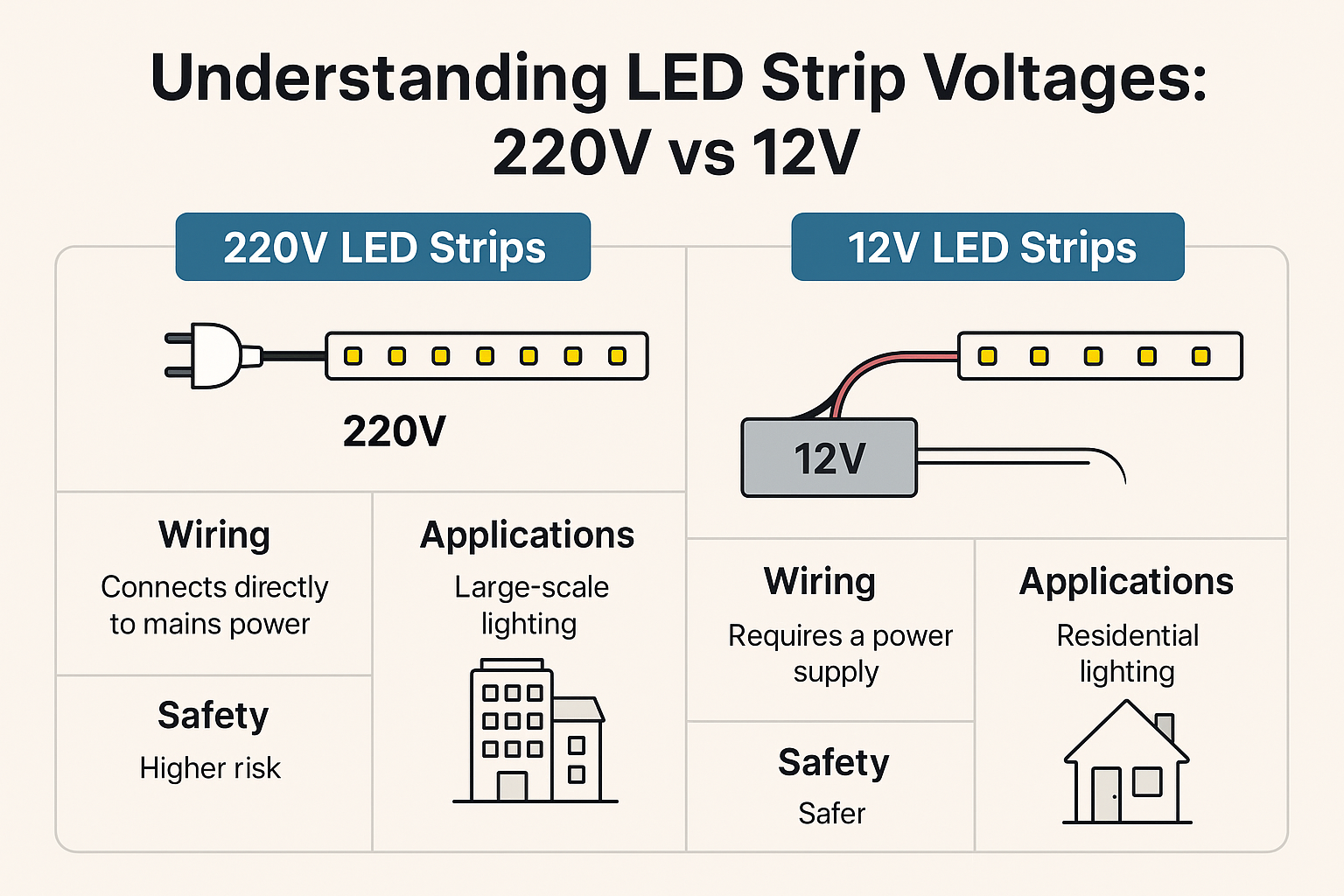
Technical Differences Clearly Explained
Clearly understanding the technical distinctions between 220V and 12V LED strip lights is essential for selecting the right option tailored to your specific project requirements.
Voltage Requirements & Power Supplies
- 220V LED Strips:
Operate directly from standard household power without needing external power adapters or transformers, simplifying installation, particularly for extended runs.
- 12V LED Strips:
Require external transformers or power adapters to step down household voltage, adding an extra component but enhancing overall safety and control.
Brightness & Lighting Performance
- 220V LED Strips:
Typically deliver strong, consistent brightness over long distances without significant voltage drop, making them suitable for expansive or commercial installations.
- 12V LED Strips:
Offer excellent brightness and color consistency in shorter installations but can experience brightness drops over longer distances, usually mitigated by multiple power supplies.
Inline FAQ: Are 220V LED strips brighter than 12V strips?
220V strips generally maintain stable brightness over longer lengths without voltage drop, while 12V strips offer excellent brightness but may require additional power supplies for long runs.
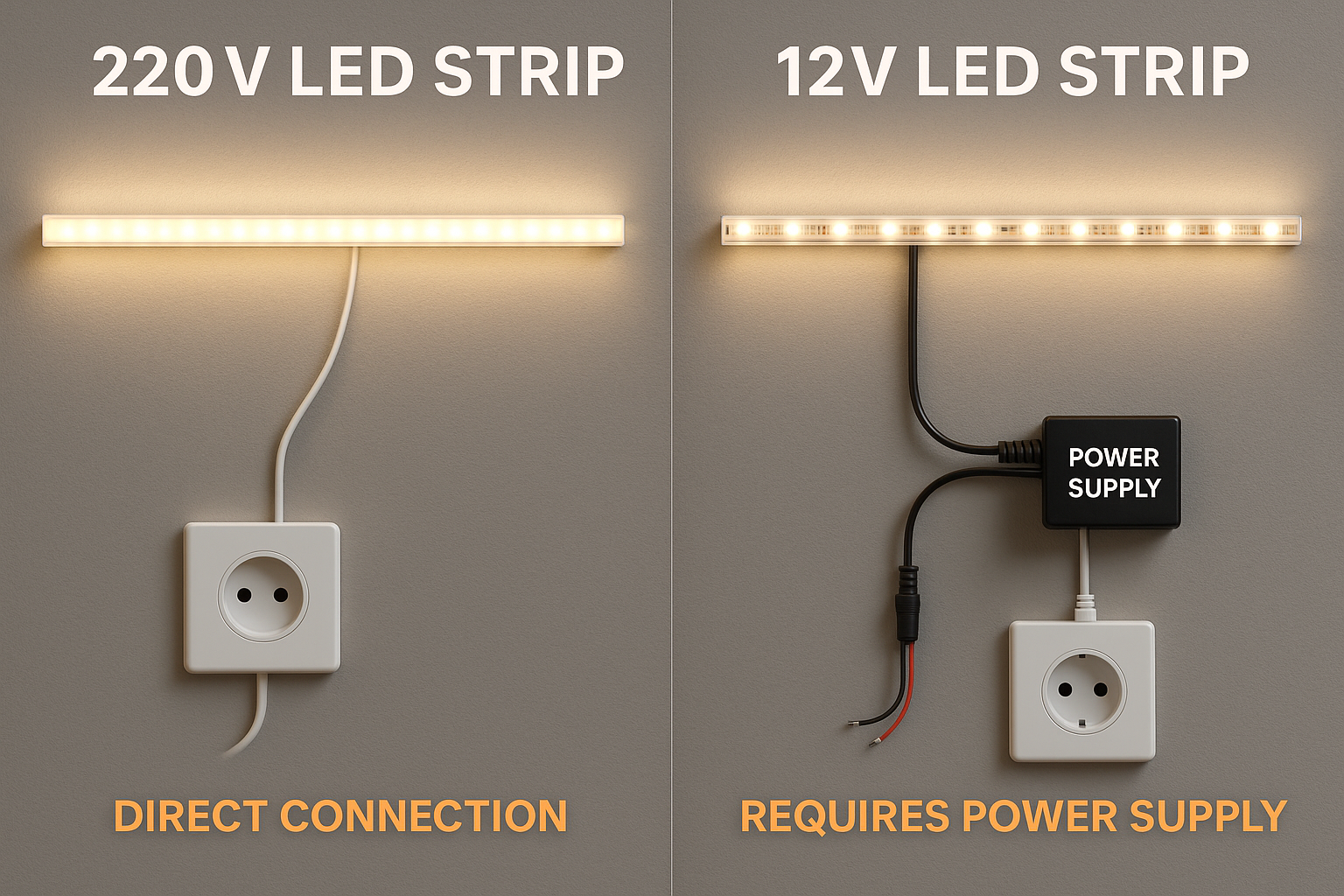
Safety Considerations: 220V vs 12V LED Strips
Safety is a critical factor when choosing between 220V and 12V LED strips. Here’s a clear overview of the safety aspects associated with each type, helping you make a safe and informed decision.
Safety Factors for 220V LED Strips
- Higher Risk:
Due to operating directly at mains voltage, 220V LED strips pose a higher electrical risk if improperly handled or installed.
- Installation Precautions:
Proper insulation, grounding, and professional installation are highly recommended to minimize risks, especially in damp or outdoor environments.
Safety Advantages of 12V LED Strips
- Lower Voltage, Higher Safety:
Operating at a significantly lower voltage, 12V LED strips are safer and present minimal risk of electric shock, ideal for residential and easily accessible installations.
- Ease of Handling:
Installation and maintenance can be safely managed even by non-professionals, making these strips particularly user-friendly and ideal for DIY projects.
Inline FAQ: Are 220V LED strips safe?
While 220V LED strips can be safe when professionally installed and adequately insulated, they inherently carry a higher risk than 12V strips due to the higher voltage, requiring careful safety considerations.
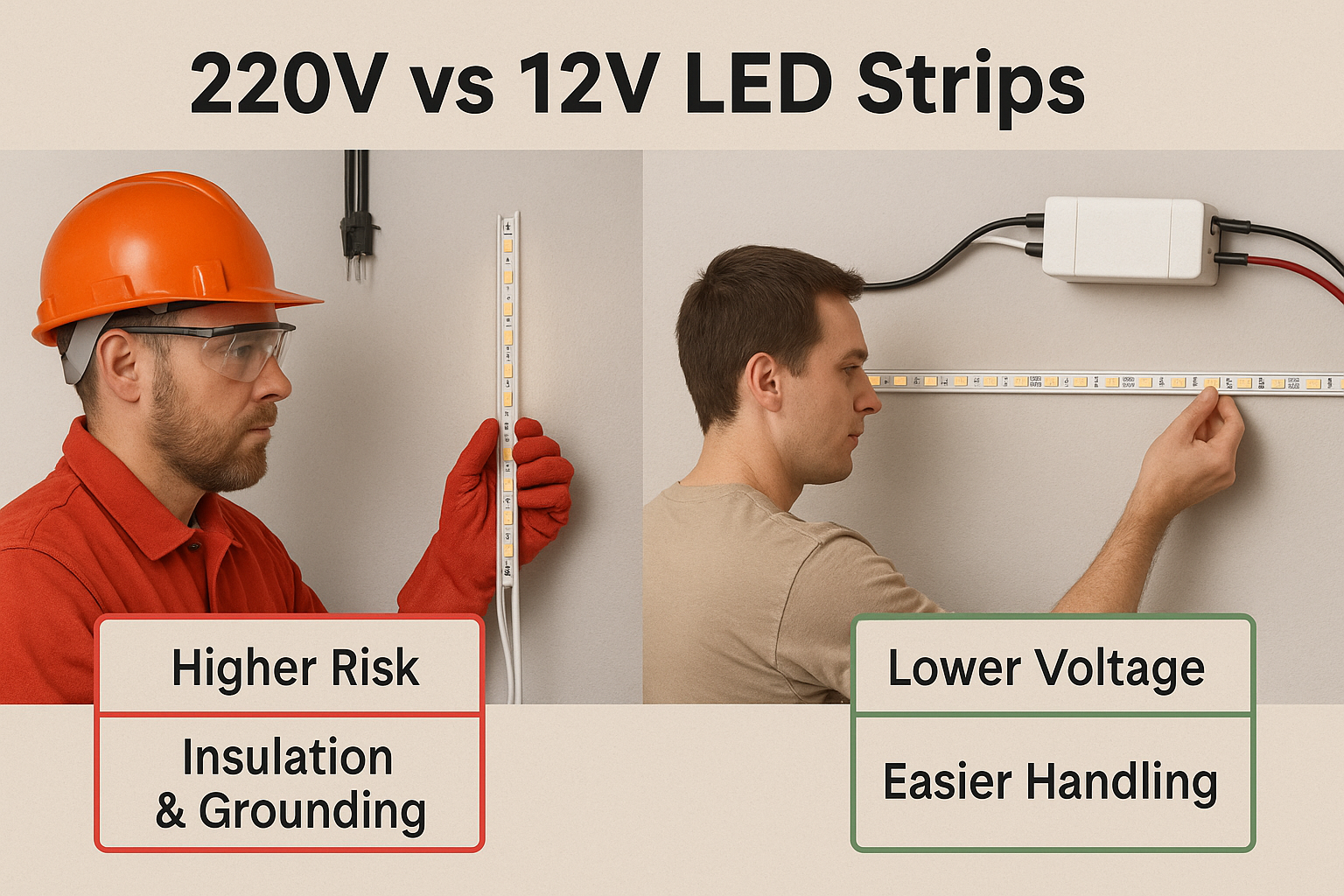
Advantages and Disadvantages Clearly Compared
A clear comparison of advantages and disadvantages between 220V and 12V LED strip lights helps you identify which option aligns best with your specific lighting needs and preferences.
Pros and Cons of 220V LED Strips
Advantages:
- Longer Runs without Voltage Drop:
Can run extensive distances without noticeable voltage drop, ideal for large-scale projects.
- Reduced Power Supply Needs:
Requires fewer or no external transformers, simplifying large installations.
Disadvantages:
- Higher Safety Risk:
Elevated electrical risk due to direct mains connection, demanding careful insulation and professional installation.
- Limited Flexibility:
Less adaptable for intricate lighting designs or DIY home applications.
Pros and Cons of 12V LED Strips
Advantages:
- Enhanced Safety:
Lower voltage significantly reduces electrical hazards, ideal for home and DIY projects.
- Greater Flexibility:
Easier to install in intricate or customized designs due to simpler handling and wiring.
- كفاءة الطاقة:
Typically offers excellent energy efficiency and consistent performance for smaller installations.
Disadvantages:
- Voltage Drop Issues:
Longer strips may require additional power supplies to maintain consistent brightness.
- Additional Equipment:
Necessitates external transformers or adapters, increasing installation complexity slightly.
Inline FAQ: Are 12V LED strips better for residential use than 220V strips?
Yes, 12V LED strips are typically safer, easier to handle, and more suitable for residential and decorative applications, whereas 220V strips are preferred for commercial or larger-scale installations.
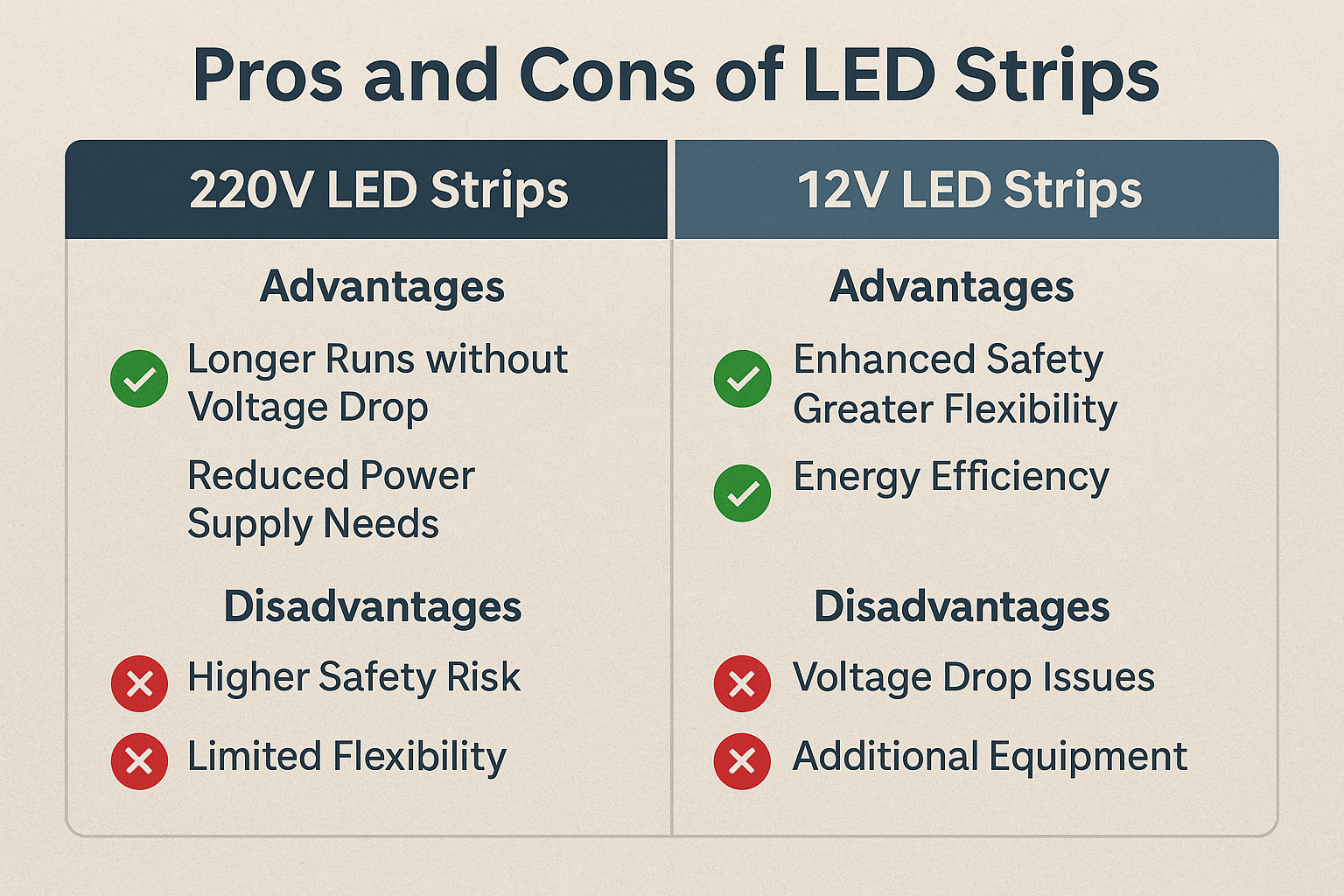
Best Applications & Practical Scenarios
Clearly understanding ideal applications for 220V and 12V LED strip lights helps you choose the best option tailored specifically to your project needs.
When to Use 220V LED Strips
220V LED strips are ideal for:
- Large-scale Commercial Projects:
Suitable for extensive lighting setups in retail stores, warehouses, and commercial buildings due to minimal voltage drop and simplified wiring.
- Outdoor & Long-distance Installations:
Excellent choice for external building outlines, architectural lighting, or any scenario requiring extended runs without frequent power injection.
When to Use 12V LED Strips
12V LED strips are perfect for:
- Residential and Interior Lighting:
Ideal for decorative lighting in homes, apartments, and small commercial spaces due to safety and ease of installation.
- Detailed and Intricate Installations:
Optimal for accent lighting, furniture detailing, or intricate lighting designs, offering greater flexibility and easier DIY handling.
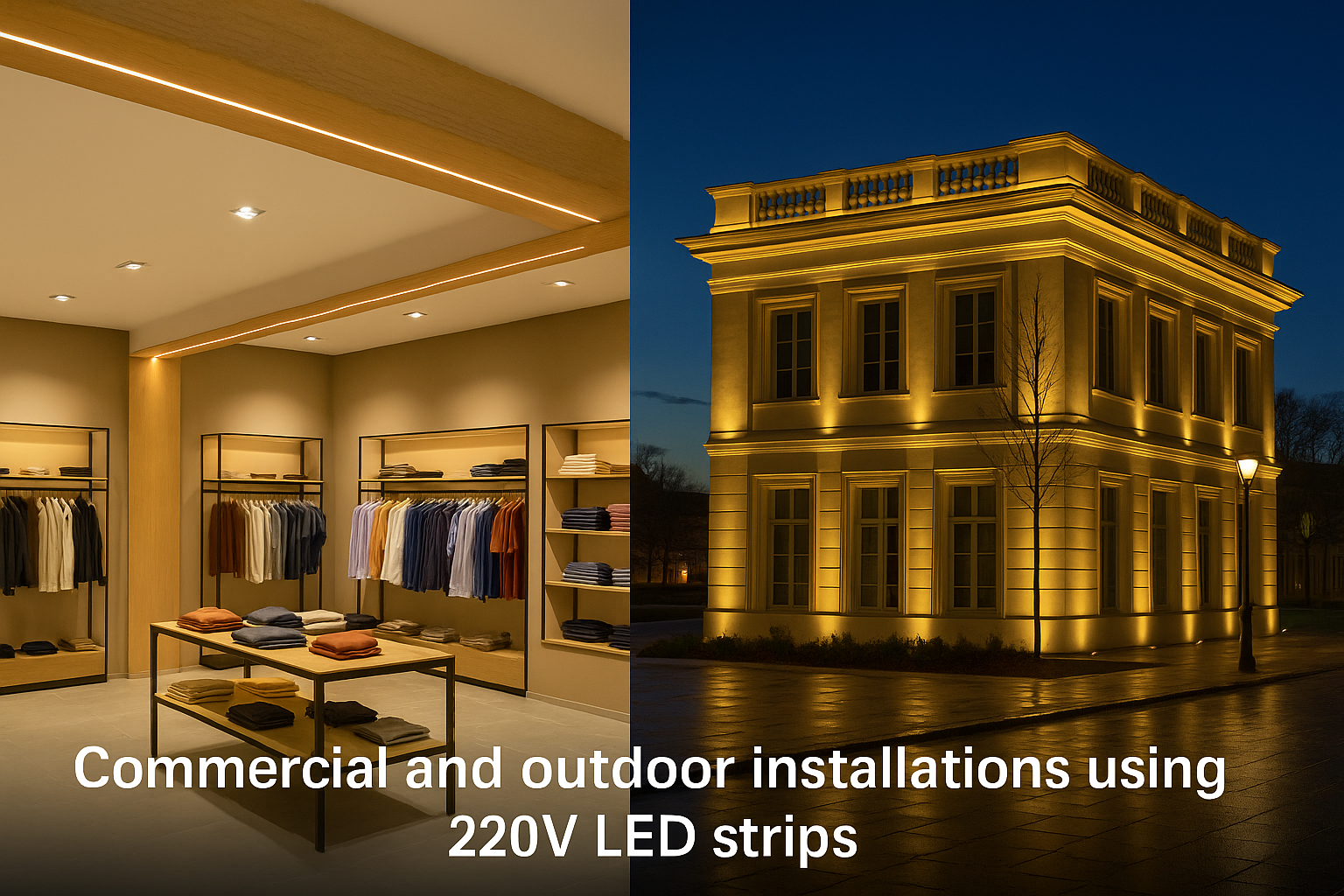
How to Choose Between 220V and 12V LED Strips
Clearly determining whether to use 220V or 12V LED strips depends on several practical factors. Here’s a straightforward guide to help you make the most suitable choice for your specific lighting project.
Key Decision Factors Clearly Outlined
- Project Scale:
Choose 220V LED strips for extensive or large-scale installations, whereas 12V strips are ideal for smaller, detailed residential and decorative lighting.
- Safety Requirements:
Opt for 12V LED strips in scenarios requiring maximum safety, particularly in accessible areas or DIY projects.
- Installation Complexity:
Select 12V LED strips for simpler installation and flexibility, while 220V strips may require professional handling due to safety concerns.
- Budget Considerations:
Consider the costs associated with additional power supplies for 12V strips or professional installation requirements for 220V strips.
Common Mistakes and Tips
- Ignoring Safety:
Always prioritize safety—choose low-voltage (12V) strips for accessible installations to minimize electrical hazards.
- Underestimating Voltage Drop:
When using 12V strips, plan additional power injections for extended runs to maintain consistent brightness and prevent voltage drops.
- Choosing Based Solely on Cost:
Clearly evaluate long-term performance, safety, and installation complexity rather than just initial cost differences.
External Link:
Detailed Differences Between 12V, 24V, and 220V LED Strips – Wedooled
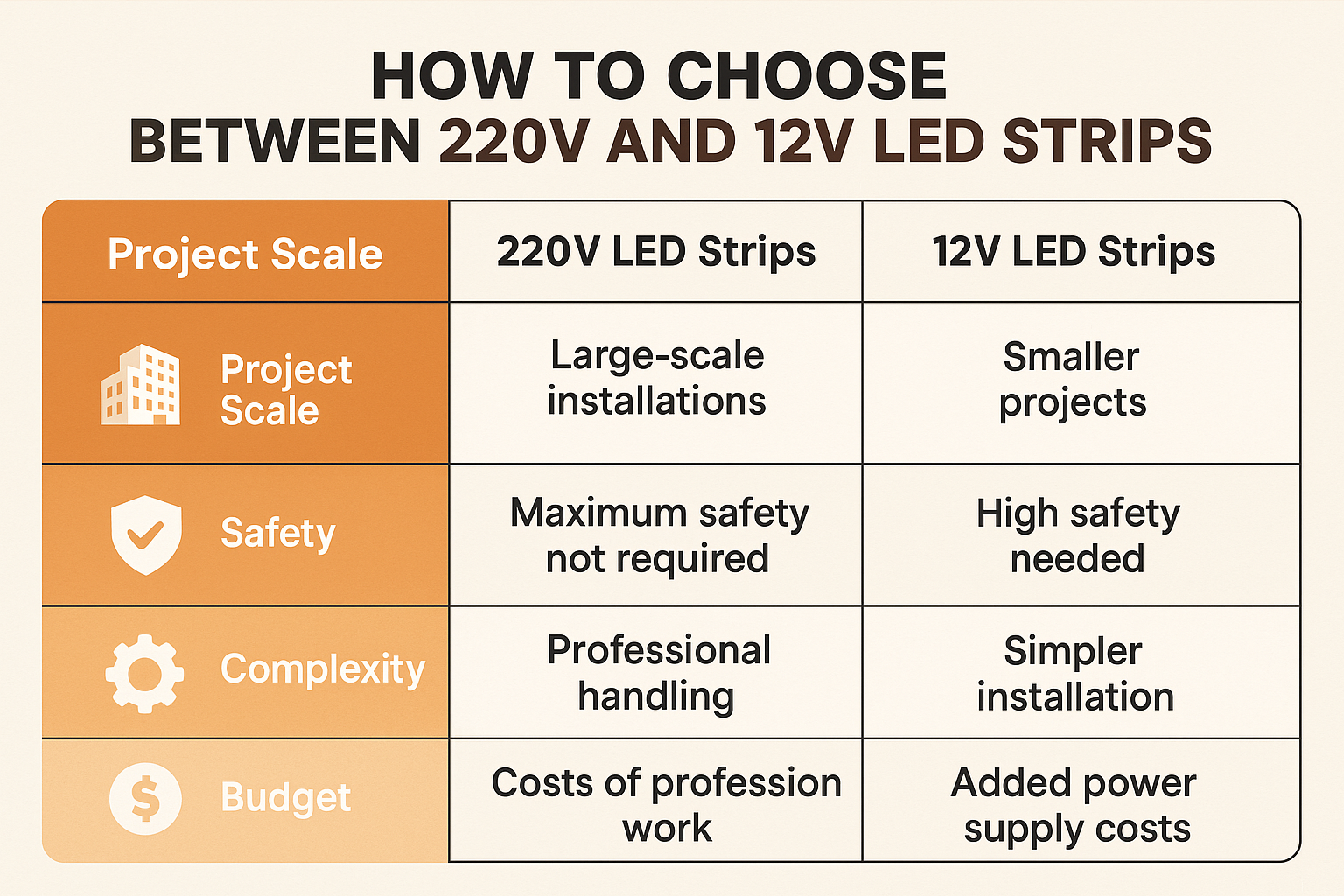
Installation & Expert Recommendations
Proper installation ensures optimal performance, longevity, and safety of both 220V and 12V LED strip lights. Here are clear step-by-step guidelines, expert recommendations, and troubleshooting tips to help you achieve a successful installation.
Step-by-Step Installation Guide
For 220V LED Strips:
- Plan and Measure:
Clearly identify lighting placement and carefully measure the required length.
- Ensure Safety:
Turn off power before installation, wear insulated gloves, and use properly rated connectors.
- Secure Installation:
Use appropriate mounting hardware, ensuring strips are securely attached and connections insulated properly.
- Test Carefully:
Turn on the power gradually, and test thoroughly before finalizing installation.
For 12V LED Strips:
- Prepare Surface:
Clean the installation surface thoroughly for optimal adhesion.
- Mount the LED Strips:
Attach strips using adhesive backing or mounting clips, ensuring a secure, even installation.
- Connect to Power Supply:
Clearly match polarity and voltage ratings, using a properly rated 12V transformer.
- Power-Up and Test:
Confirm all connections, turn on power, and ensure even brightness and proper operation.
Expert Recommendations & Practical Tips
- Quality Matters:
Invest in high-quality LED strips and power supplies from reputable manufacturers to ensure reliability and longevity.
- Safety First:
Always prioritize electrical safety, especially when dealing with 220V strips. Consider professional installation if uncertain.
- Plan for Voltage Drop:
For 12V LED strips, include additional power injection points for longer runs to maintain consistent brightness.
استكشاف المشكلات الشائعة وإصلاحها
- Uneven Brightness:
Verify power supply adequacy and ensure proper power injection for extended 12V runs.
- Overheating (220V Strips):
Improve ventilation, ensure proper spacing and insulation, and follow recommended wattage limits.
- Strips Not Lighting Up:
Check connections, confirm correct voltage supply, and inspect for any wiring issues or polarity errors.
Inline FAQ: What common issues occur during installation of 220V and 12V LED strips?
Common installation issues include incorrect polarity connections, insufficient power supply causing dimming or flickering, overheating due to inadequate ventilation, and safety hazards in high-voltage setups.
FAQs About 220V and 12V LED Strip Lights
Below are clear, concise answers to frequently asked questions about 220V and 12V LED strip lights, helping you quickly resolve common queries and make informed decisions.
Are 220V LED strips safe?
220V LED strips can be safe if installed professionally, properly insulated, and used with appropriate protective measures. However, due to higher voltage, they inherently carry more risk than 12V strips, making careful handling essential.
Which voltage LED strip is more energy-efficient?
Generally, 12V LED strips are more energy-efficient due to lower voltage and better energy conversion efficiency. While 220V strips handle longer distances without voltage drop, 12V strips typically offer superior efficiency for shorter or decorative installations.
Can 220V LED strips be used outdoors?
Yes, 220V LED strips are suitable for outdoor use, provided they have the proper IP (Ingress Protection) rating and insulation. Always ensure that strips intended for outdoor environments are explicitly rated for weather resistance and clearly installed with appropriate safety measures.
Conclusion & Next Steps
Clearly understanding the differences between 220V and 12V LED strip lights allows you to confidently choose the best option tailored precisely to your lighting needs. While 220V strips are ideal for extensive installations and outdoor settings due to their simplicity and reduced power supply requirements, 12V strips excel in safety, flexibility, and energy efficiency, perfect for residential and decorative applications.
Evaluate your project’s specific requirements—scale, safety, complexity, and budget—to select the optimal LED strip voltage for your application.







